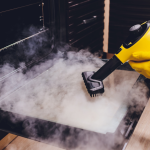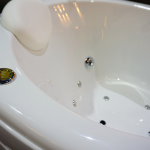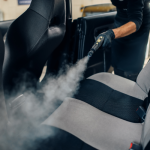Concrete patios and driveways are valuable for their affordability and durability. Thoroughly cleaning patio slabs after the winter accumulation of dirt and algae is a worthwhile effort, as it greatly enhances the appeal of your outdoor space.
Algae, mold, and organic stains often affect patios, particularly in regions with frequent rain and mild winters. To maintain the natural look of your slabs, whether they are stone, cement, or concrete, it’s advisable to conduct a thorough cleaning each spring.
Frequency of Cleaning a Concrete Patio
A yearly cleaning is generally sufficient for most patios. Springtime is ideal for clearing away the accumulated grime of winter. However, consider an additional clean in the fall to address any food or oil stains from grilling.
Complete Patio Cleaning Guide
Here’s an efficient method for cleaning concrete or cement patios, with or without a power washer, be it for spring cleaning or tackling tough stains.
Step 1: Clear and Prep the Patio
Remove all items like pots, furniture, and grills from the patio. Sweep off leaves, debris, and loose dirt. Cover nearby plants or landscaping with a tarp for protection.
Step 2: Tackling Various Patio Stains
Water, Mold, and Mildew Stains
For water stains or mildew, use a power washer or garden hose. If ineffective, mix 3/4 cup of bleach with 1 gallon of water and scrub the area wearing protective gear like rubber gloves. Rinse thoroughly with clean water. Ensure the patio is fully dry before replacing decor or furniture.
Oil and Grease Stains
Spread sawdust, cornstarch, or baking soda over spills to absorb them. Alternatively, create a paste with baking soda and water. Gently rub the stain with this paste and let it sit for 30 to 60 minutes. Then, rinse or sweep away the residue.
If dealing with older oil stains, be aware that the concrete might be more deeply affected. In such cases, use a degreaser as per the manufacturer’s instructions.
Rust Stains
White vinegar is an effective, eco-friendly solution for rust stains on cement patios. For deep stains, apply it directly and let it sit for up to an hour. Use a strong-bristled scrub brush, following the original texture of the concrete to avoid scratches. After scrubbing, rinse and let it air dry. Repeat if necessary, or use a concrete rust remover for stubborn stains.
Step 3: Cleaning the Patio Floor
Using Dish Soap and Water
Dish soap acts as an efficient degreaser, effectively removing oil and grime from concrete surfaces. Mix a few drops of dish soap with warm water to create a cleaning solution. Apply it to the patio, let it sit for a while, then scrub and rinse with fresh water. Repeat as necessary.
Vinegar or Baking Soda Mixture
These natural cleaners are excellent for tough rust or charcoal stains on cement patios. Scrub the patio with a solution of equal parts vinegar and water, followed by a thorough rinse. If stains persist, apply pure vinegar. Avoid using vinegar or baking soda in power washers. To minimize irritation, wear gloves, safety goggles, and a mask.
Bleach Solution
Put on rubber gloves and sprinkle a bleach solution over the patio using a cup. Scrub with a mop or soft-bristled push broom. Let it sit for around 10 minutes, then rinse with cool water from a hose.
Concrete Patio Cleaner
These products, often made with concentrated alkaline soap, help loosen oil on porous concrete. They might be less effective on older stains.
Pressure Washer
Pressure washing is a quick and effective method. It’s commonly done with a bleach and water mixture. Some manufacturers advise against using pressure washers on their paving, so test a small area first. Start with lower pressure and increase as needed, avoiding excessive pressure on chipped areas. Clean in sections to prevent pressure buildup.
Muriatic Acid
Often used for garage floors or driveways stained by oil spills, muriatic acid can brighten concrete and remove various stains. Handle with care as it can damage grass and plants and is hazardous. Wear protective gear, including a respirator, and follow manufacturer’s instructions.
Step 4: Cleaning and Refreshing Furniture
Use the Fortador Volt Mini portable steamer for effective cleaning of patio furniture. Its high heat and pressure clean stubborn stains and grease without harsh chemicals, preserving furniture’s surface integrity.
Preventing Patio Stains
Prevent stains on cement patios with a concrete sealer. Apply it yourself with a paint roller or sprayer, or hire a professional. It’s also a good time to inspect and repair any deck damage.
If unsure about a cleaning solution, test it in a hidden area first. Clean thoroughly while wearing safety gear and taking necessary precautions.
Preventing Algae
To combat algae, maintain a regular cleaning routine. Remove dead leaves with a stiff brush or broom and keep the patio free of debris. Apply a slow-acting patio cleaner from our selection for easy results and to prevent regrowth.
Deep Cleaning Patio Slabs
A pressure washer is ideal for deep cleaning patio slabs. Inspect your patio once or twice a year, depending on the weather. Combine with a cleaning solution for more thorough cleaning and to prevent moss and lichen growth.
Does Bleach Damage Patio Slabs?
Bleach is a harsh chemical and should be a last resort. It can damage block pavers and artificially colored concrete. Avoid using it near vegetation, as it can harm plants.
Best Heavy-Duty Steamer for Patios
The Fortador PRO Steamer, powered by a Lamborghini engine, is an eco-friendly option for patio cleaning. It doesn’t require harsh chemicals and comes with various attachments.
Best Portable Steamer for Patio Furniture
The Fortador Volt Mini portable steamer is great for patio furniture. It combines high heat and pressure to remove stains and grease, ensuring a thorough clean without damaging the furniture’s surface. Its compact design makes it versatile for various cleaning tasks.




